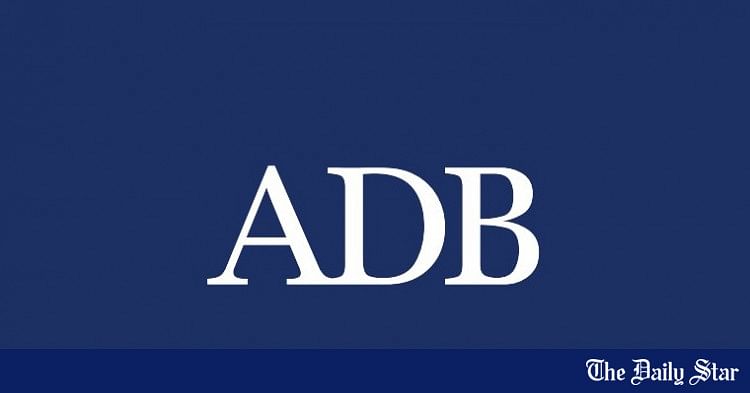The Asian Development Bank has identified four major risks to Bangladesh’s economy, including the potential impact of additional US tariffs and political uncertainty, both of which could hinder growth and fuel inflationary pressures.
The ADB, in its April Asian Development Outlook, revised Bangladesh’s GDP growth forecast for FY25 to 3.9 percent from 4.3 percent, citing persistent economic challenges. The Manila-based lender, however, expects the economy to recover and grow by 5.1 percent in the next fiscal year.
Inflation is projected to accelerate to an average of 10.2 percent in FY25 and ease to 8 percent in FY26.
Besides the impact of higher US tariffs, Bangladesh may face increased inflation and fiscal deficit due to higher election-related spending and subsidies, the ADB said in the report.
It said persistently high inflation and prolonged monetary tightening may dampen household consumption and private investment, weakening growth momentum. Remittance inflows may decline if political uncertainty persists or if the exchange rate regime fails to offer sufficient incentives for using official channels, which may also hit growth.
Finally, unpredictable weather is a perennial risk, the ADB added.
The growth forecasts were finalised before the US announced new tariffs on April 2, meaning the baseline projections account only for previously existing tariffs.
Speaking to journalists at the report’s launch in Dhaka yesterday, ADB Country Director Hoe Yun Jeong said that the full impact of the tariffs will be assessed and published in the bank’s July update.
The US is a crucial market for Bangladesh, particularly for its readymade garment sector, so these tariffs could have an adverse effect, he noted.
However, Jeong emphasised that it is still too early to determine the precise scale of the impact on Bangladesh.
Beyond the US, other key export markets, including Europe, may also experience a decline in demand. The overall effect will hinge on the extent of trade disruptions and economic slowdown in those regions, he added.
Jeong mentioned that Bangladesh has already started communicating with US authorities, while other RMG exporters are also facing higher tariffs.
“Engaging and negotiating with the US government is important, but this is a short-term measure. Bangladesh must diversify its products and markets for exports, which is a long-term perspective,” he said.
The ADB country director also said that the government can take this opportunity to rationalise its own import tariff structure and reform its non-tariff barriers for all other countries, not just the US, as Bangladesh’s tariff regime is overly protective.
He pointed out persistently high inflation as the government’s most important challenge since it erodes purchasing power and worsens people’s hardship. The government should also focus on mitigating supply chain disruptions.
When asked whether the ADB would work on raising a collective voice among Asian countries as the new US tariffs pose a significant risk to Asia, Jeong said the Dhaka office did not receive any message from Manila.
Apart from US tariffs, the ADB report warned that escalation in the Middle East could lead to renewed supply chain disruptions, as well as higher food and energy prices, global economic uncertainty, and risk aversion.
Continued uncertainty over the war in Ukraine also presents downside risks to the global economic environment, it said.
Regarding the recent economic situation, the ADB said Bangladesh’s GDP growth sharply declined to 1.8 percent from 6 percent year-on-year in the July-September quarter of FY25. The decline was driven by political instability, natural disasters, disruptions at factories due to worker protests, and high inflation, all of which dampened demand.
However, growth is expected to improve in the following quarters, driven by manufacturing. Agricultural growth is also expected to moderate following repeated floods.
GDP growth is expected to recover in FY26 on higher domestic demand while easing inflation and rising remittances are likely to raise private consumption and investment, the ADB said.
Imports are expected to increase with the central bank lifting restrictions on letters of credit, and export growth will accelerate on expected recovery in the European Union, a major destination for Bangladesh’s exports. Net exports are thus likely to add marginally to growth.
On the supply side, higher growth in industry and services is expected to contribute to recovery. Industrial output is likely to expand as investor confidence is anticipated to improve ahead of elections scheduled between December 2025 and June 2026, and due to the interim government’s implementation of the reforms.
The ADB said enduring inflation remains a significant hurdle due to market inefficiency brought on by regulatory shortcomings, restrained competition in wholesale markets, insufficient market information, supply chain constraints, and depreciation of the taka.
With expected moderation of global fuel and commodity prices, inflation is expected to ease in the remaining months of FY2025, but the fiscal year average is expected to be in double digits.
However, assuming favourable weather, moderating global oil prices, and tighter monetary and fiscal stances, inflation is projected to ease in FY2026.
The ADB hoped that a move toward an exchange rate system fully determined by the market would provide for automatic adjustments to economic imbalances, enhance monetary policy effectiveness, and increase the inflow of remittances, thereby expanding foreign exchange reserves.


